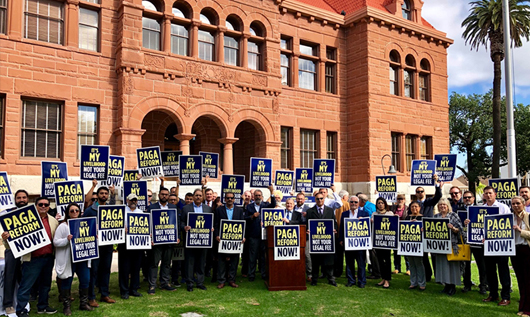Opinion
Abuse of PAGA leads to Lawsuit

By TOM MANZO | President of the California Business & Industrial Alliance
Dec. 19, 2018
The Private Attorney General Act (PAGA) was signed into law in 2003 by Gray Davis and championed by Senator Joe Dunn. Davis spent 1,778 days as governor and signed 5,132 bills into law and that is an average of 2.89 bills a day. PAGA was approved by Governor Gray Davis on October 12, 2003, just five days after the California electorate voted to recall him from office.
If you are not familiar with PAGA, this law deputizes each and every California employee (and his or her private contingency-fee attorneys) to sue their employers on behalf of the State. The California Labor Laws are composed of myriad rules, standards, and obligations, which touch nearly every aspect of the employment relationship. Many of the California Labor Laws are unclear, cumbersome, counter intuitive and impossible to follow. It is no wonder as the California Labor Law Digest published by the Chamber is over 1,100 pages.
If you are take your lunch later than 5 hours, even a second, it is a violation, or a gift card for the holidays is not put into the overtime rate is a violation. Do you have proper commission agreements? Third break after 10 hours or waived lunch? The list of potential traps just keeps going and it is impossible to follow all of these regulations and many are not appropriate for some industries. The Labor Laws cannot be a one size fits all and I think the only ones who understand these complex laws are the trial attorneys suing businesses daily.
Since this law was enacted over 35,000 PAGA notices have been sent out by the state and most turn into class action lawsuits costing employers millions. PAGA is used by the trial lawyers to start the process and many times settlement amounts going to the state are negotiated in mediation. As a matter of fact what is supposed to go to the aggrieved employees is also negotiated in mediation and what are not negotiable are the trial attorney’s fees thanks to the state.
An employee alleges (without any proof) that for the past year, he has worked 2 minutes of “of-the-c1ock” overtime each pay period attending to miscellaneous tasks related to opening or closing Employer’s place of business. Under the Starbucks decision, discussed supra, the employee has a cognizable claim of failure to pay minimum wages and overtime. Employer has 30 employees and weekly pay periods. Employee’s hourly rate of pay is $ 11.00 per hour, which means the approximate amount of unpaid minimum wages is: $19.07 (2 minutes x 52 pay periods: 104 minutes; 104 minutes / 60 minutes: 1.73 hours; 1.73 hours x $11.00: $19.07), and the approximate amount of unpaid overtime wages are: $9.54 ($19.07 x. 0.5: $ 9.54). So the total approximate amount of wages Employer failed to pay Employee, unknowingly, is $28.61.
Through PAGA, this employee has authority to seek a maximum of $69,508.61 civil penalties and personal damages for the alleged failure of Employer to pay Employee: $28.61, which are 2,430 times the alleged actual damages. With 30 employees your exposure is over 2 million dollars and this does not include employees no longer working for you. Those employees are owed 30 days’ pay and waiting time penalties.
What happens next is where things really go wrong as this employee will never see $ 69,000. All of that is done in negotiations behind closed doors. That Starbucks employee received a check for less than $ 700 and the rest goes to the trial lawyer and the state.
Our organization The California Business & Industrial Alliance filed suit against the State of California on November 28th of this year challenging its constitutionality. The complaint is 54 pages spelling out how this law began and where we are at today. It is time business owners, community leaders, legislators, all learned more about how badly this law is abused and helped facilitate real reform. Employers and employees both lose when it comes to PAGA.
The views expressed above are those of the author and do not necessarily reflect those of the Inland Empire Business Journal.

Career & Workplace
California Continues to Struggle with Labor Supply as Employment Expands Modestly

State’s Unemployment Rate Remains Highest In Nation
California’s labor market expanded modestly in April, with total nonfarm employment in the state growing by 5,200 positions over the month, according to an analysis released today by Beacon Economics. March’s gains were revised down to 18,200 in the latest numbers, a 10,100 decline from the preliminary estimate of 28,300.
As of April 2024, California has recovered all of the jobs that were lost in March and April 2020, and there are now 314,300 more people employed in the state compared to February 2020. Total nonfarm employment has grown 1.8% over this time compared to a 3.9% increase in the United States overall. California increased payrolls by 1.2% from April 2023 to April 2024, trailing the 1.8% increase nationally over the same period.
The state’s unemployment rate held steady at 5.3% in April 2024, unchanged from the previous month. California’s unemployment rate is the highest in the nation and remains elevated relative to the 3.9% rate in the United States as a whole. The state continues to struggle with its labor supply, which remained essentially unchanged in April (declining by a negligible 100). Since February 2020, California’s labor force has fallen by -246,200 workers, a -1.3% decline. In comparison, over the past twelve months the nation’s labor force has increased by 0.8%.
Industry Profile
- At the industry level, job gains were mixed in April. Health Care led the way with payrolls expanding by 10,100, an increase of 0.4% on a month-over-month basis. With these gains Health Care payrolls are now 13.6% above their pre-pandemic peak.
- Other sectors posting strong gains during the month were Transportation, Warehousing, and Utilities (3,700 or 0.4%), Leisure and Hospitality (3,100 or 0.2%), Government (2,600 or 0.1%), Education (1,800 or 0.4%), Retail Trade (1,000 or 0.1%), and Wholesale Trade (400 or 0.1%).
- Payrolls decreased a handful of sectors in April. Construction experienced the largest declines, with payrolls falling by -6,000, a contraction of -0.6% on a month-over-month basis. Note that this decline was largely due to late season storms affecting construction projects across the state.
- Other sectors posting significant declines during the month were Manufacturing (-5,300 or -0.4%), Professional, Scientific, and Technical Services (-3,600 or -0.3%), Real Estate (-700 or -0.2%), Finance and Insurance (-700 or -0.1%), Administrative Support (-600 or -0.1%), and Information (-600 or -0.1%).
Regional Profile
- Regionally, job gains were led by Southern California. Los Angeles (MD) saw the largest increase, where payrolls grew by 5,700 (0.2%) during the month. The Inland Empire (2,600 or 0.2%) and San Diego (1,200 or 0.1%) also saw their payrolls jump during the month. However, payrolls fell in Orange County (-2,700 or -0.2%), Ventura (-500 or -0.2%), and El Centro (-2,200 or -0.3%). Over the past year, El Centro (1.9%) has had the fastest job growth in the region, followed by the Inland Empire (1.5%), Ventura (1.4%), Orange County (1.1%), San Diego (0.8%), and Los Angeles (MD) (0.6%).
- In the Bay Area, the East Bay experienced the largest increase, with payrolls expanding by 2,600 (0.2%) positions in April. San Rafael (MD) (200 or 0.2%) and Napa (100 or 0.1%) also saw payrolls increase during the month. However, San Francisco (MD) (-1,700 or -0.1%), Santa Rosa (-600 or -0.3%), and Vallejo (-600 or -0.2%) experienced payroll declines during the month. Over the past 12 months, Vallejo (3.0%) enjoyed the fastest job growth in the region, followed by Santa Rosa (2.3%), Napa (2.2%), San Rafael (MD) (1.6%), the East Bay (0.9%), San Jose (0.2%), and San Francisco (MD) (-0.8%).
- In the Central Valley, Sacramento experienced the largest monthly increase as payrolls expanded by 900 (0.1%) positions in April. Payrolls in Yuba (400 or 0.8%), Bakersfield (300 or 0.1%), Fresno (300 or 0.1%), and Visalia (100 or 0.1%) increased as well. However, payrolls fell in Stockton (-500 or -0.2%), Modesto (-200 or -0.1%), Merced (-200 or -0.3%), Redding (-100 or -0.1%), and Hanford (-100 or -0.2%). Over the past year, Madera (5.7%) had the fastest growth, followed by Yuba (4.2%), Merced (3.7%), Modesto (3.6%), Sacramento (2.5%), Hanford (2.4%), Redding (2.3%), Fresno (2.2%), Visalia (2.1%), Stockton (2.0%), Chico (1.5%), and Bakersfield (1.1%).
- On California’s Central Coast, Salinas (200 or 0.1%) and Santa Cruz (200 or 0.2%) added the largest number of jobs during the month. Santa Barbara (-100 or -0.1%) saw payrolls decline. From April 2023 to April 2024, Salinas (1.9%) has added jobs at the fastest rate, followed by Santa Cruz (1.6%), Santa Barbara (0.8%), and San Luis Obispo (0.5%).
Banking & Financial Services
Rate Changes are Looming: Follow Long-Term Game Plan for Winning Capital Decisions

Four key strategies for borrowing during interest-rate uncertainty
By Greg Martinez-Miller
While basketball fans everywhere are following NBA schedules, business owners are tracking the 2024 Fed meeting schedule. But just as true hoops enthusiasts know that game strategy is comprised of more than three-point shots, so should business owners remember that interest rates aren’t the only factor for long-term success. Last December, the Fed said that it expected to cut rates, which are at a 22-year high, three times in 2024. Yet when the central bank met in March, it left rates unchanged, saying it didn’t want to jeopardize lower inflation and healthy economic growth.
So, when the Federal Open Market Committee meets again on April 30-May 1, anticipation will be high. Prognosticators are on every channel, wondering whether the central bank will keep its 5.25-5.5% target rate unchanged again, or if it will announce the first of its three cuts. And if it does, observers ask, how could lower rates impact growth in the U.S. economy?
As a commercial banker who has watched the interest rate scoreboard over the past 16 years, here’s my advice from the sidelines: Stick to your long-term game plan. Put your company in a position to win the balance-sheet game when it comes to the cost of capital.
Here are my four key strategies from my dogeared playbook to keep your head in the game:
1. See the court
Do not focus on interest rates alone for your capital strategy. You need to be aware of other negotiated factors when funding your company’s financial future. Besides interest rates, other terms — loan maturity, advance rates, and guarantees — can offer important value. Many times, it makes good strategic sense to pivot from the interest rate toward other terms to advance your company’s medium- and long-term game plan.
2. Do not overreact to the officials
The Fed is like an economic referee, making calls to control the economy’s pace. Do not lose your cool when the whistle blows. Three rate reductions are still expected this year, but when the central bank plans to make that call, no one knows – yet.
3. Manage the clock
Think about timing when it comes to borrowing. When rates dip, you might consider making a few key borrowing moves to fund some crucial projects and wait to fund other projects later in the game. Consider the purpose of the debt on your balance sheet. Would your company benefit from having a mix of floating and fixed rates? This may allow you to hedge and still potentially benefit from low floating rates, while also maintaining certainty for longer-term, fixed rates.
4. Stick with your game plan
When rates do change, do not throw out your playbook. Instead, call a time out and consult with your banker or interest rate risk advisor to help ensure your borrowing decisions match your company’s long-term plans and goals for continued growth and success.
If you do not need capital, do not borrow just to lock in a lower rate. Interest rates should not be the driving factor when making borrowing decisions. Borrow when you need to; have a good reason for it.
Remember, interest rate changes will always interrupt the flow of your game. But your goal is to ensure that your financial future is deliberate – not purely defensive, based on the ebb and flow of interest rates.
Greg Martinez-Miller is the commercial banking leader for Wells Fargo in Inland Empire. Based in Ontario, Martinez-Miller leads a team of commercial relationship managers in Riverside and San Bernardino Counties. The views expressed present the opinions of the author on prospective trends and related matters in middle market banking trends as of this date, and do not necessarily reflect the views of Wells Fargo & Co., its affiliates and subsidiaries.
Opinion
Despite Popular Narratives, California’s Economy is Doing Fine…For Now

Leading Economic Forecast Pushes Back Against “Doom and Gloom” Prophecies; State’s Housing Supply Problem At The Crux Of Slowing Economy
California is far from becoming the ‘failed state’ depicted by critics, and even a cursory look at the data proves it, says one of the state’s leading economic forecasts. According to Beacon Economics‘ latest outlook for California, the state’s economy will continue to grow in the near future and there is little sign of a recession in 2024.
Consider a few of the new forecast’s findings:
- Since just prior to the pandemic, the number of jobs in California has grown by only 2.1%, compared to 3.7% in the nation as a whole, however, the state’s private sector output has grown by 10% compared to just 8% in the nation overall. This means that California’s output has expanded through greater worker productivity.
- California’s median household income grew by 9.2% from 2019 to 2022, compared to just 8% growth in the nation overall. Median incomes in the state are now 14.3% higher than in the U.S. as a whole, the largest gap ever seen in this data.
- Real income (accounts for inflation) has increased despite persistent claims to the contrary. Official data from the U.S. Bureau of Labor Statistics shows a 20% increase in consumer prices in California between the end of 2019 and the end of 2023, but a 23% increase in workers’ average weekly earnings over the same period. Importantly, the earnings growth has been greatest among lower skilled workers, according to the new forecast.
- From 2019 to 2022, the average poverty rate in California was 12%, lower than the U.S. average and the lowest level ever seen in the state.
The new forecast is careful to acknowledge California’s glaring problems, including its housing shortage and massive budget deficit, but argues that untruthful and excessively negative narratives are making things materially worse by affecting the way leaders spend their time and do their jobs.
“The state’s economy certainly has its share of problems, but many of these issues are things that can be solved with some pragmatic changes to state policy,” said Christopher Thornberg, Founding Partner of Beacon Economics and the forecast author. “When pessimistic public narratives take hold, no matter how false or overblown, elected leaders tend to veer off on impractical missions to fix problems that don’t really exist – at least not in the way these artificial narratives say they do.”
One of the most urgent, and real, challenges facing California this year is it’s colossal budget deficit of between $35 and $70 billion, depending on who you ask. But according to the new forecast, this gap is not a function of the state’s economy, which is growing, it is the obvious (and oft repeated) result of a volatile revenue system that badly needs to be overhauled.
“California loves soak-the-rich policies, and our high marginal tax rate on high-income earners means that when financial markets are hot, revenues surge, but when asset values fall or crash, it cuts deeply into the state’s tax haul,” said Thornberg. “On top of that, we have a mishmash of band aid type laws that have been put in place over the years which force a certain amount of spending, preventing lawmakers from saving for lean times.”
All that said, according to Thornberg, California’s biggest budgetary problem today is not with revenues but expenditures. “State spending is currently 40% higher than it was pre-pandemic, and as painful as it is, the deficit will not fully go away until either programs are cut back or new taxes are raised, both of which would be incredibly difficult to achieve,” he said.
In terms of the state’s economic future, perhaps California’s most burning dilemma is its low supply of housing, which has driven infamously high housing costs and a declining population, ergo workforce. According to the forecast, the only way to fix the problem is to sharply expand the pace of new housing supply. “This is a tremendously consequential issue for the economy and population of the state – a workforce cannot grow if there is nowhere for workers to live,” said Thornberg. “The inability to genuinely tackle our housing supply issue is slowing the mighty California economic machine and the effects we’ve started to see in the past few years will only grow worse.”
View the new The Beacon Outlook California including full forecast tables here.
-

 Technology3 weeks ago
Technology3 weeks agoRevolutionizing Recycling: Ontario Scientist Unveils Breakthrough in Plastic Processing
-

 Transportation4 weeks ago
Transportation4 weeks agoBrightline West Breaks Ground on America’s First High-Speed Rail Project Connecting Las Vegas to Rancho Cucamonga
-

 Technology3 weeks ago
Technology3 weeks agoUnveiling the Future: The Inland Empire Technology Summit 2024
-

 Banking & Financial Services3 weeks ago
Banking & Financial Services3 weeks agoRate Changes are Looming: Follow Long-Term Game Plan for Winning Capital Decisions
-

 Entertainment18 hours ago
Entertainment18 hours agoSouthern California’s newest destination is poised for even greater success in the coming years
-

 Education2 weeks ago
Education2 weeks agoCalifornia State Superintendent Tony Thurmond Inspires at Inland Empire Education and Workforce Summit












